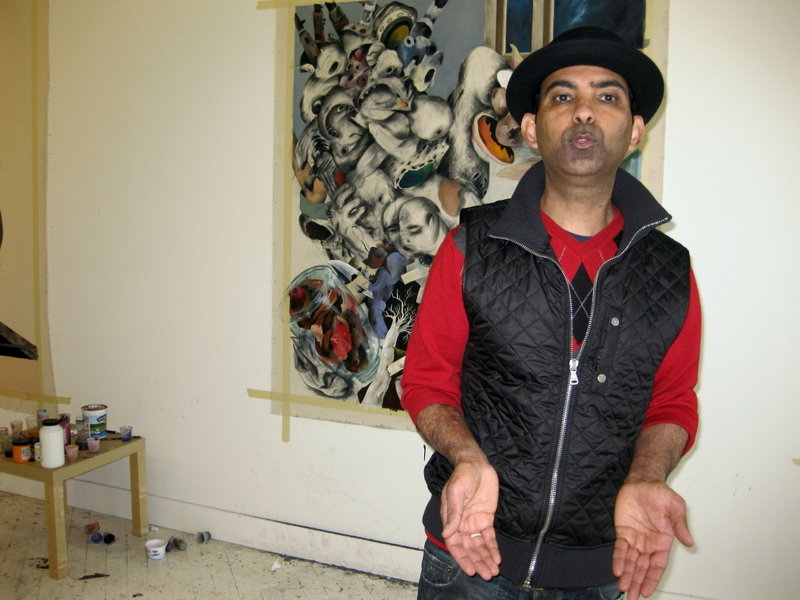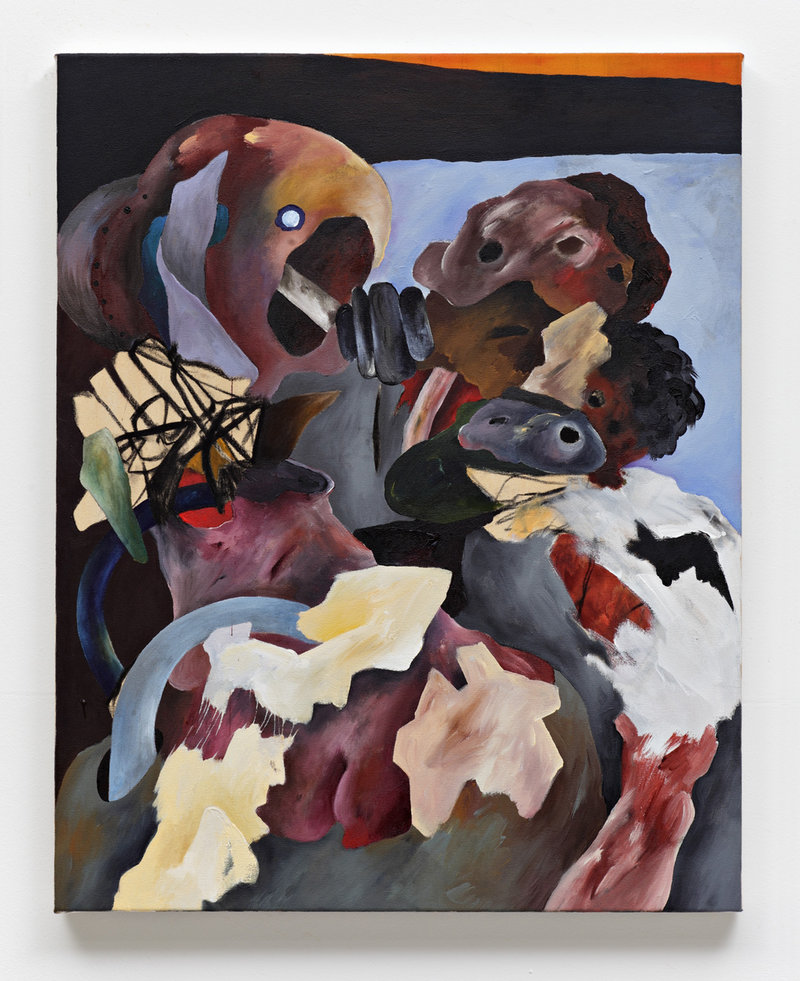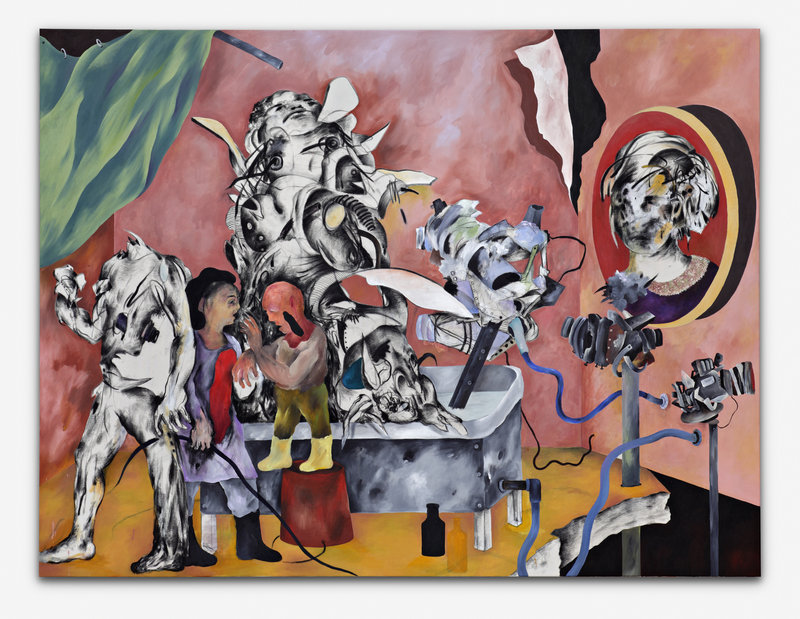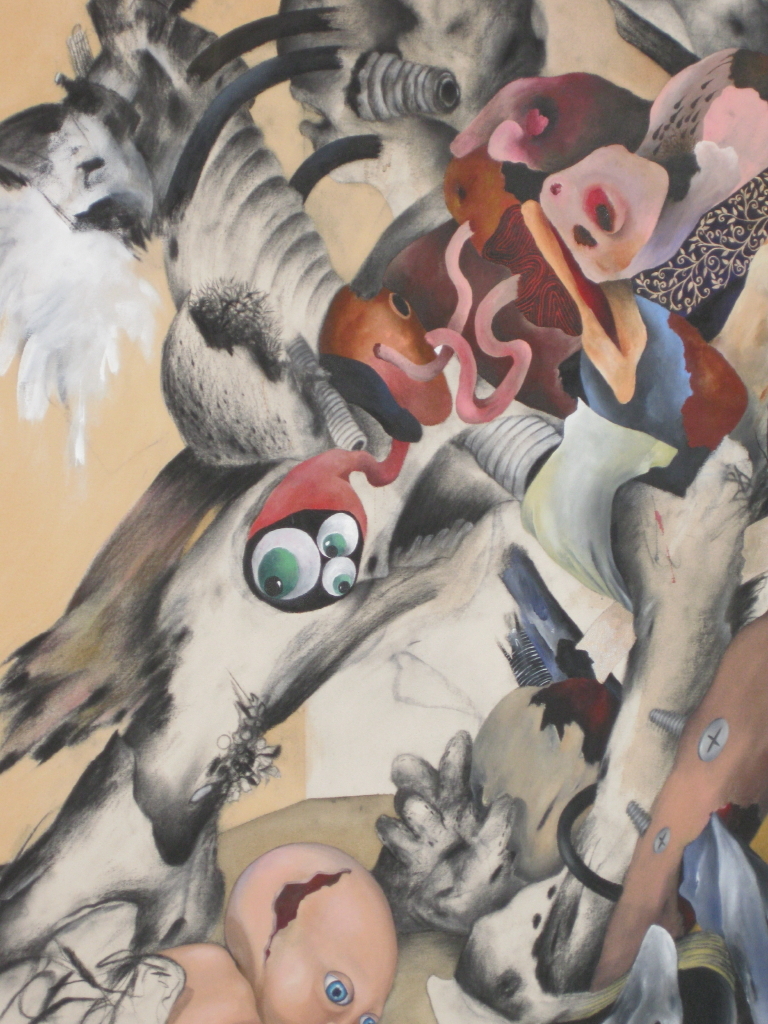NEW YORK – Fifteen years ago, just a few months shy of his 20th birthday, Ahmed Alsoudani defaced a mural of Saddam Hussein in his Baghdad neighborhood.
It was a youthful prank. Politics wasn’t part of Alsoudani’s vocabulary. He wasn’t protesting anything.
But the consequences were steep. The Saddam regime was violent and unpredictable, and Alsoudani felt at risk in a city full of fear and threat.
A frightened teenager, he arranged for a final tea with his family, assuming he would never see them again, and quietly slipped away. He traveled by taxi to Kurdistan and eventually to Syria, where he lived four years before seeking and receiving political asylum from the U.S. Embassy in Damascus.
Alsoudani eventually landed in the United States, made his way to Maine and found himself on a hot afternoon in August 2001 on Portland’s Spring Street, staring up a long set of steps to the entrance of the Clapp House. At the time, Clapp was home to the admissions office of Maine College of Art.
Alsoudani spoke little English and had no portfolio to speak of — just a few rough paintings he carried with him. But he wanted to be an artist, and MECA was his best hope.
Circumstance, fate and Alsoudani’s stubborn nature brought him to that moment. He summoned the courage, stepped into the imposing Greek Revival building and announced in a humble, broken voice, “My name is Ahmed, and I would like to be a painter.”
Not quite a decade later, Alsoudani — now 35, fluent in English and living a dreamy international life — was named to Forbes Magazine’s “Watch List” as one of the most collectible emerging artists, and is a leading voice of visual expression from vanguard Middle Eastern artists.
His paintings sell for $70,000 each, and he has collectors all over the world. He counts among his patrons the most influential names in modern art, including mega-collector Charles Saatchi. He’s been invited to show at the Venice Biennale in 2011 and is working on a private commission of a large painting for the opening for the Museum of Modern Art in Doha, Qatar, in 2011.
A PINCH-ME MOMENT
But it was a moment earlier this spring when Alsoudani realized that his dream of becoming a famous painter not only had come true, but had come true in wildly unimaginable ways.
Art-world royalty Francois Pinault, owner of Christie’s auction house and of an art collection considered among the most valuable in the world, requested a private studio visit. It was one of those moments that caused Alsoudani to pause, catch his breath and steady himself.
“He’s a big supporter of my work, and he came to my building in person,” Alsoudani said during a recent interview. “That’s a big deal for a guy who graduated from Maine College of Art.”
That’s a big deal for anybody.
Alsoudani’s arrival as an international art star seemed destined. Right away, his work caught the attention of MECA’s painting faculty, and in particular his first professor, Sean Foley, who encouraged Alsoudani’s use of color and exaggerated, shocking images.
He came to Maine at a fateful moment in his own life and in the history of the modern world. A month into his Portland residency, terrorists attacked on U.S. soil. Revenge swept the country into war. A newcomer to America with dark skin and a Middle Eastern accent, Alsoudani stood witnesses to terrorism, suffered ignorance and intolerance, and watched helplessly as his chosen adopted country tore apart his native land. He recognized images of Baghdad neighborhoods on TV, and feared for his family’s survival each and every day.
His early drawings suggested chaos and confusion. His work became increasingly violent and graphic.
“Most of my work deals with the war,” he said in advance of a Portland gallery show during his undergraduate MECA days. “The war for me is a life-and-death issue. I’ve been dealing with it since before I’ve been here, and it’s hard to step away from it. I’m not interested in showing blood and war. I’m working really hard to capture the moment between when the aircraft are attacking and the moment after the attack, that line between life and death.”
RESEARCH AND DEVELOPMENT
He worked furiously and quietly in Maine, developing technique and style. He graduated from MECA in 2005, spent the summer of 2006 at the Skowhegan School of Painting and Sculpture, and then disappeared to New Haven, Conn., for graduate study at Yale.
When he emerged from Yale in 2008, he closely resembled the artist he has become: Confident, energetic and unafraid to tackle the horrors of war from the perspective of the oppressed. His images, executed on huge pieces of canvas and paper in oil, acrylic, charcoal and pastel, show the remains of those left on the ground when the bombing stops: suffering humanity, in piles of body parts, howling in pain and shredded of dignity, with references to Pablo Picasso, Max Beckmann, Otto Dix and Goya.
His paintings have the context of the real world, and evoke an urgency unique to the artist’s complicated personal perspective.
The work resonated, and Alsoudani’s recognition soared.
Last year was particularly good, with exhibitions in London, Dubai, New York and Berlin.
“Ahmed is having a very exciting career,” said his New York dealer, Robert Goff. “From right out of the gate, there has been tons of chatter and buzz and excitement for his work. It hasn’t abated. It’s gotten more intense and exciting. He’s moved into the interesting and fun part of the art world that is high-level.”
Alsoudani lived in Berlin for a short time, but found his way home to New York last fall. In Manhattan, he is in the middle of everything that matters. He lives in Soho and has a studio in Chelsea. The Robert Goff Gallery is a two-minute walk — convenient for collectors who want to meet the artist or who request a private studio visit.
That happens all the time these days. On one recent Saturday, the gallery called him on his cell phone to inform him that husband-and-wife collectors had stopped in and wanted to meet him.
“Tell them I will be over,” Alsoudani said.
Thirty minutes later, he is shaking hands in the back of the gallery with Joel and Zoe Dictrow, who own one of his pieces. They talk for another 15 minutes. Alsoudani is gracious, patient and engaging.
He says goodbye, attends to some quick gallery business and then slides back out into the sun of a warm spring afternoon in New York.
His studio is on the upper floor of a warehouse-style building on West 21st St. Alsoudani’s studio opens off a commons area that includes a kitchen and huge dining room table. He offers a visitor a slice of fruit bread.
The studio is soft and light, and there’s a calmness to the space. Billie Holiday music plays on the CD player. For all the turmoil that Alsoudani portrays in his work, he plants himself in a peaceful, light-filled space. Eight pieces are tacked and taped up on the 14-foot walls. Five are works in progress. Three are complete.
One of the larger works likely will end up at the museum in Qatar. Alsoudani would like to keep one of the smaller ones. “But it’s hard to keep one for myself. We have a lot of demand. We have a waiting list,” he said.
The studio is neat, orderly. Small tables hold tubes of paint, and strands of tape pile up on the floor. Ladders lean against a wall.
FREEDOM TO CREATE
His success has earned him latitude in his schedule, but Alsoudani maintains a routine. He generally arrives at the studio around noon and works late into the night. Alsoudani spends about 10 hours a day in his studio — but less than half that time actively working. “Laziness is part of the process of painting,” he said, laughing. But the laugh merely relieves the tension. He estimates that during any given day, he makes somewhere between 10 and 15 decisions that affect the outcome of a painting.
It’s solitary work “and it’s why painters drink,” he said. “the end of the day, you need a drink.”
Painting gives him his greatest joy, and alone in the privacy of his studio Alsoudani finds a way to shut out the noise. He is under great pressure to continue to produce valuable works. He tries not to dwell on the business side of his career, though he admits it’s hard not to think about it all the time when the stakes keep rising. Not very long ago, he thought it was “crazy” that people would spend $25,000 for one of his paintings. Now, the conversation starts at $70,000.
He makes no apologies for enjoying the benefits of his status, and gives ready credit to the discipline that he learned as an undergrad at MECA for keeping him grounded and focused. He is certain he would not have succeeded if not for attention he received at the Portland art school.
“It’s a small community, and they care. I don’t think that I would be able to survive as a student anywhere else except there. For the first two or probably three years, I was literally needing someone to work with me one-on-one all the time. And it happened.”
He also knows that he is lucky — in life and in art. He got out of Baghdad just in time and ended up in Maine at just the right time. He takes nothing for granted, and knows that what he’s achieved today could be gone tomorrow. He also knows that his journey has just begun.
If nothing else, the hard truths of his own life have taught him at least that much.
“Looking at the history of painting, the moment you start to neglect your work people start to neglect you. You’ll probably be OK for two years or so, but the moment you think you dominate your spot, you’re mistaken. Literally, there are tens of thousands of artists just in New York. Do I ever think I’m better than they are? No. I’ve had a better chance to show my work. I’m luckier than they are.
“Hopefully I will spend my life painting and creating something that people pay attention to for the long run.”
Staff Writer Bob Keyes can be contacted at 791-6457 or at: bkeyes@pressherald.com
Send questions/comments to the editors.







Comments are no longer available on this story